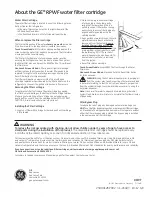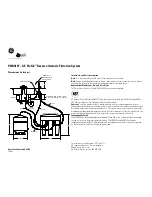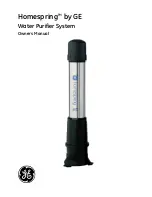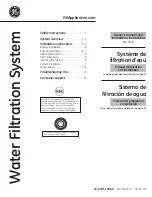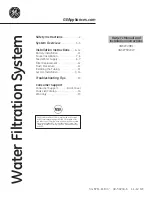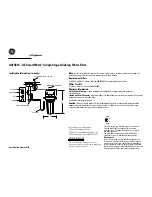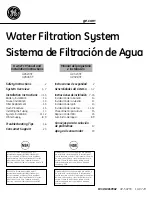
Installation and Service Manual – L Series Reverse Osmosis System
Systems and Components
Membranes
,
Filters
,
Chemicals
2325 Cousteau Ct., Vista, CA 92081 USA • www.appliedmembranes.com • E-mail: [email protected]
Page 4
Copyright © 2008 Applied Membranes, Inc. All Rights Reserved.
Model
Design Conditions
Limits*
Line Sizes (Inches)
Pump model and HP
Permeate Flow
Conc.
Flow to
Drain
(GPM)
Design
Recycle
Flow
(GMP)
Design
Recovery
(%)
Max.
Recovery*
(%)
Max.
Recycle
Flow*
(GPM)
Inlet Perm.
Conc.
Design
Pump
Flow
(GPM)
Pump Model No.
Motor
Model
Motor
HP
Full Load
Amps
(FLA)@
indicated
voltage
GPD GPM
L-94A-216
14,400 9.0 4.5
2.0
65
75 3.0
0.75
0.75
0.5 15.5
HPS20H
W/PUMP
3
17
L-94A-215
14,400
9.0
4.5
2.0
65
75
3.0
0.75
0.75
0.5
15.5
HPS20H3-D1-MS4 W/PUMP
3
17
L-94A-235
14,400 9.0 4.5
2.0
65
75
3.0 0.75
0.75
0.5 15.5 HPS20H3-D1MS3 W/PUMP
3
10
L-94A-236
14,400
9.0
4.5
2.0
65
75
3.0
0.75
0.75
0.5
15.5
HPS20H3
W/PUMP
3
10
L-94A-436
14,400 9.0 4.5
2.0
65
75 3.0
0.75
0.75
0.5 15.5
HPS20H3
W/PUMP
3
5
L-104A-216
16,000
10.0
4.5
2.0
65
75
3.0
0.75
0.75
0.5
16.5
HPS20H
W/PUMP
3
17
L-104A-215
16,000 10.0 4.5
2.0
65
75
3.0 0.75
0.75
0.5 16.5
HPS20H3-D1-MS4 W/PUMP
3
17
L-104A-235
16,000
10.0
4.5
2.0
65
75
3.0
0.75
0.75
0.5
16.5
HPS20H3-D1MS3
W/PUMP
3
10
L-104A-236
16,000 10.0 4.5
2.0
65
75 3.0
0.75
0.75
0.5 16.5
HPS20H3
W/PUMP
3
10
L-104A-436
16,000
10.0
4.5
2.0
65
75
3.0
0.75
0.75
0.5
16.5
HPS20H3
W/PUMP
3
5
L-114A-216
17,300 11.0 4.5
2.0
65
75 3.0
0.75
0.75
0.5 17.5
HPS20H
W/PUMP
3
17
L-114A-215
17,300
11.0
4.5
2.0
65
75
3.0
0.75
0.75
0.5
17.5
HPS20H3-D1-MS4 W/PUMP
3
17
L-114A-235
17,300 11.0 4.5
2.0
65
75
3.0 0.75
0.75
0.5 17.5 HPS20H3-D1MS3 W/PUMP
3
10
L-114A-236
17,300
11.0
4.5
2.0
65
75
3.0
0.75
0.75
0.5
17.5
HPS20H3
W/PUMP
3
10
L-114A-436
17,300 11.0 4.5
2.0
65
75 3.0
0.75
0.75
0.5 17.5
HPS20H3
W/PUMP
3
5
L-124A-216
19,000
12.0
4.5
2.0
65
75
3.0
0.75
0.75
0.5
18.5
HPS20H
W/PUMP
3
17
L-124A-215
19,000 12.0 4.5
2.0
65
75
3.0 0.75
0.75
0.5 18.5
HPS20H3-D1-MS4 W/PUMP
3
17
L-124A-235
19,000
12.0
4.5
2.0
65
75
3.0
0.75
0.75
0.5
18.5
HPS20H3-D1MS3
W/PUMP
3
10
L-124A-236
19,000 12.0 4.5
2.0
65
75 3.0
0.75
0.75
0.5 18.5
HPS20H3
W/PUMP
3
10
L-124A-436
19,000
12.0
4.5
2.0
65
75
3.0
0.75
0.75
0.5
18.5
HPS20H3
W/PUMP
3
5
*
Water must be softened or have antiscalant injection. Check with factory to make sure this recovery will not cause any scaling problems with your feedwater.
• L-12521A uses 21” Membrane M-T2521AHF & Housing PV2521SSAW-316
• All other 2.5” diameter use 40” Membrane M-T2540AHF and Housing PV2540SSAW-316
• 4.0” diameter model no. M-T4040AHF. Vessel model: PV4040SSAW-316
Design Basis
• Systems rated at: 77°F (25°C) using 1000 PPM sodium chloride solution operating at 200 psi pressure.
• Minimum feed pressure to RO System: 40 PSI. System capacity changes significantly with water temperature. For
higher TDS a water analysis must be supplied and could result in modifications to the system.
• Chlorine must be removed if present in feed water prior to RO with a carbon filter or with chemical injection.
• Water must be pretreated with a softener or antiscalant injection to avoid scaling the membranes.
• Feed water turbidity: Less than 1 NTU; Feed water silt density index (SDI): 3 maximum. If exceeded, pretreatment with
media filter recommended. All pretreatment equipment and SDI test kits are available from Applied Membranes.
• Capacity Basis: 24 hrs/day
Design Notes
1.
Pump flow/Feed flow:
The pump has been designed to include recycle flow (if any) coming back to the pump inlet
from the concentrate stream based on desired recovery. The sum of permeate flow, concentrate flow and recycle flow
(if any) will equal the pump design flow.
2.
Permeate flow:
Indicates design flow rate from RO membranes as product water for use.
3.
Concentrate flow:
Water flowing to the drain. Concentrate flow is critical for proper system operation. For proper
concentrate flows, refer to the system design information on pages 3-4.
4.
Recycle flow:
Flow stream that returns from the concentrate line back to the pump intake, rather than to the drain.
Note:
Permeate flow should not exceed recommended flow.
Note:
System pressure is a variable. It is important to adjust the pressure to get the correct permeate
and concentrate flows. The exact value of the pressure is not important.
Note:
Permeate flow will increase at higher temperature.




















